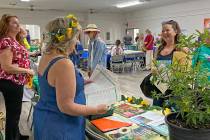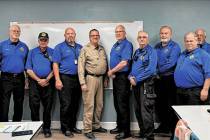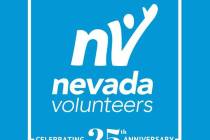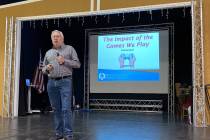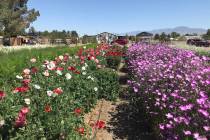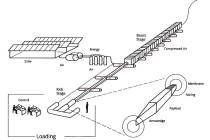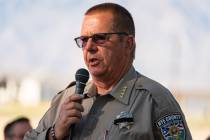1848 gold discovery a profound piece of history
What would you say are the half-dozen most important events in American history?
I would place America’s Declaration of Independence from Britain first, followed by the Civil War. For the No. 3 slot, some contenders would be World War II, the Cold War, and the Louisiana Purchase, but my choice would be James Marshall’s discovery of gold at Sutter’s Fort in California in January 1848.
Marshall’s discovery triggered the greatest rush to riches in history. It set the template for the development of the American West. For the next 60 years, when someone found valuable minerals, usually gold or silver, wealth-seekers rushed to the site to try their luck. Towns sprang to life, merchants set up shop, farms and ranches typically were established nearby to feed everybody. Roads were built and in some cases railroads constructed, and industry moved in. The discovery of gold in California spawned a long list of boom towns throughout the West. Virginia City, where silver was found in 1859, became the mother camp of Nevada and led to such thriving communities as Aurora (1860), Austin (1862), Eureka (1864), Belmont (1865), Tybo (1870), Tonopah (1900), Goldfield (1902), and Rhyolite (1906).
Prior to Marshall’s discovery of California gold, America’s core values were developing, emphasizing competition, private property, and every man for himself. The gold rush helped enshrine those values.
When you look at the history of Nye County, all its boom towns from the 1860s on were echoes — some large, many small — of what happened when James Marshall found gold while constructing a mill at Sutter’s Fort.
Not long ago, I was lucky enough to come across an interview from 1920 with an 89-year-old man, Rodney C. Adams. He was at Sutter’s Fort when Marshall made his world-changing discovery. Excerpts from Mr. Adams’s interview follow.
Rodney C. Adams
“I recall that morning in January, 1848, when James Marshall found the first gold,” said Mr. Adams, as he sat in his granddaughter’s home at Hemet, California, the other day. “I was vacquero for Captain John Sutter, although I was but a youth. I was away with cattle the morning Marshall found the gold.
“I got back to the ranch house late in that afternoon, and Jim Marshall, who had been building a mill race for Sutter’s grist mill, was sitting on the house front steps. I recall that Marshall was more cheerful than usual.
“He motioned me to come to him, as I dropped from my mustang, and said in low tones:
“‘Rod, what’d you say if I could show you this whole country full of gold?’
“What could I say, a green boy off the plains? What did I know of a gold-crazy world? I kept my mouth shut, and looked wise. Marshall then took me to one side, and told me in half-whispers how he had found five chunks of native gold as large as filberts. He showed me the nuggets, upon which he had experimented by boiling, hammering and scraping to find whether they really were gold. Marshall had no idea then that his discovery was so important. His mind was set on the mill which he had almost finished and on several mechanical devices he had invented in it. Among the things he said to me about the gold he had found was that some day he was going to hunt systematically for more gold nuggets and that he might get a few thousand dollars of a fortune together in that way. He had absolutely no idea of the vastness of the mining possibilities his discovery would lead to.
“So little did the finding of the gold disturb either of us that I remember that we went to bed early and slept soundly. Marshall cautioned me to keep the gold find a secret. But Marshall was loquacious and he himself bragged of his find. Five days later several Mexicans brought in more nuggets. Then the Mormons, who were working for Sutter and Marshall, found gold and the importance of the find increased a little in the minds of Marshall and all of us at the Coloma camp. A few years later, when the world’s commerce was turned, as Lord Derby said, by the gold discovery in California, and when more than 300,000 young men had flocked to California, and had made a new civilization, I wondered how we could have been so blind at first to the meaning of the first nuggets that Marshall picked up.
“The news did not get down to San Francisco, about 150 miles away, until three months later. When the gold was shown him, Captain Sutter said, ‘Yes, that’s gold, and it will be the curse of us’; meaning that it was the end of their schemes for a big sawmill and flour mill along the American River.
“But another week passed before the belief became general at San Francisco that back in the mountains gold had actually been found. I remember that educated men argued that the geological formation of the Sierras made the finding of gold there an absurdity. Some said the golden flakes exhibited were iron pyrites, and others laughed and said they were from a copper formation. The San Francisco Star pitied people who could believe there was gold enough in all California to buy even a respectable meal.
“Later — on May 12, I believe — a Scotch ranchman rode into San Francisco directly from the diggings. He was an intelligent and reputable man. He brought with him about 200 pounds of gold dust and nuggets to trade for merchandise. Then there was excitement and bustle. All that day and night the saloons were thronged with men who talked of nothing but the chances there might be for them in mining. One man, a Mormon, was so wild with excitement at the thought of digging gold that he went up and down the bay shore yelling, ‘Gold, gold, gold.’ Several saloon men who could not sell their stock locked up their places, determined to let them go to the dogs while they were washing gold.
“The earliest stampede of excited men to the gold diggings of California therefore began May 12, 1848. I remember that day in San Francisco. The whole population of the town did not sleep and scarcely took time to eat until the first crowd had embarked on all manner of craft up the river to what is now Stockton, thence across the country to the north fork of the American River. By the first of June the news of the discovery had gone as far down the coast as Monterey. The gold diggers at Coloma were by this time sending out so much gold to buy provisions, tools and clothing that convincing evidence of the richness of the sand bars and creek banks followed closely upon the heels of the news. All in Central California who could get away went chasing over the country toward the American Fork. Less than one-twelfth of the male population of San Francisco remained when June had come. Whole families packed up and went to Coloma. On two streets of homes and stores none but women and children remained. Half the stores and every public inn were closed because both boarders and hosts had gone to the American Fork. The village of Santa Cruz packed up and started for the mines in twenty-four hours. The news of the gold find and samples of the gold reached Monterey late in May, and in two days every man in the village but five started for the American Fork. The village of San Miguel, with some 500 population, was absolutely deserted by every human being during the first week in June, and I don’t believe there were even three men in a hundred who remained at home in California in the spring and summer of 1848. I remember hearing a fellow miner tell how he had found the jail at Monterey empty, the prisoners, sheriff and all the peace officers at the mines, and of seeing General Mason, of the United States army, and a commodore of the United States Navy, cooking their own food in a deserted hotel at Monterey, because all their servants and men had deserted in the night and had followed the rush toward the American Fork. By July there must have been about 5,000 miners at work with shovels and pans, along the American Fork, and there were arrivals from more remote localities in California every day. Between 7,000 and 8,000 Californians in that first season of gold mining, from May to January, got fully $10,000,000 worth of gold.
“The first year of gold mining in California — that is from May, 1848, to May, 1849 — was far different in its easy, quiet way from that created by the excited gold-hungry Easterners, who with the opening of the spring and summer of 1849 came swarming across the plains, over the isthmus and around the horn. There was little or no gambling. The miners left their pounds of gold under their beds and went unconcernedly miles from camp. There were no mining laws to be considered. It was a perfect mining Elysium.
“As I look back at those days now it seems we were like big children going about in a vast natural treasure house, wondering how much riches we might carry away when we were ready, but meanwhile frittering away our time and opportunities. When I remember the whole acre of gravel and sand, richer than anything ever found on the Klondike, that we abandoned because we heard of a better El Dorado on another remote creek or river, it seems as if that era must have been a dream.
“The restlessness and greed to get the very cream of the diggings kept the greater part of us poor in spite of the fabulous opportunities.”
“The unhappiest and most pitiful man of all the tens of thousands of men who washed gold up and down on almost every creek in Central California was Marshall—the discoverer of the gold. He became a drinking, profane man when he saw how his and Captain Sutter’s property was ruined by the excited gold seekers, who entered upon it without even asking the right. . . .
“I knew James Marshall intimately until he died alone and in poverty in his lonely cabin at Coloma one day in August, 1885. He became a hard drinker as he grew old. His treatment by the horde of miners embittered him against the world.”







